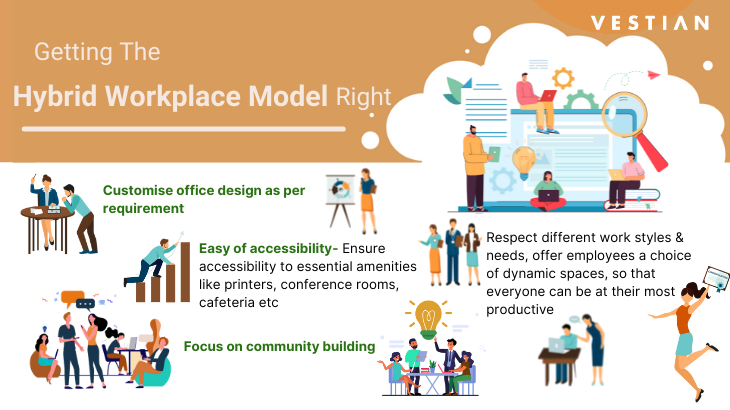A hybrid workplace model supports a mix of in-office as well as remote workers. This model has been or at least is in the process of being adopted by a vast majority of companies as a direct result of the pandemic.
Of course, the adoption of the Hybrid Workplace Model largely depends on the nature of work. For instance, a bank may not be able to offer a work-from-home opportunity to any of its employees, wherein a tech-based company can function seamlessly even if all employees work remotely. While these are two ends of the spectrum, this model works well for companies that fall somewhere in between. Many companies believe that this model gives employees the flexibility they want and in some ways is also beneficial for the business.
Workers and organizations have both seen numerous benefits of a flexible work schedule as well as the freedom to choose the place of work, including increased efficiency and a boost in the overall mood. This in fact, is being touted as one of the most compelling EVP’s in today’s scenario.
A research by Gartner estimates that almost two-thirds of employees can work remotely, sometimes. As the pandemic begins to subside, 53% of employees want to work in an office for about three days a week or fewer. Meanwhile, 79% of the C-Suite level managers plan to let their employees split their time between corporate offices and remote working, as and when required. Some other companies are taking a more flexible approach than the hybrid model. Example, at IBM when and how often their employees will go to office will be based on team focused collaborative meetings and work deliverables. Others like Ford say that their North America team would be on-site for certain meetings and projects but stay home for individual meetings. Now the main question is how to get the hybrid approach right? There is no clear answer to this.
As we witness wider adoption, companies will have to overcome multiple challenges, from space and design considerations to workforce management concerns. Health and safety will of course be the topmost priority and companies will need to take steps to avoid overcrowding at any given time. Workforce management is another key element to be considered. Businesses certainly need to set clear guidelines as to what tasks need to be accomplished at office versus what can be completed at homes. Much consideration needs to go into things like who needs to work together, coordinate schedules accordingly or also consider having office weeks instead of office days. Also providing the employees with the necessary array of digital tools, which enable them and help them know precisely what is expected of them is crucial. Moreover, these tools can also be used to categorise and assess the type, quality, and timeliness of the work done by the employees
It may still not be viable for some organisations to transition into a hybrid workplace model. This may be due to the nature of the business, lack of HR or digital framework that supports this setup or other issues related to collaboration, employee bonding, mentoring, team building, and overall discipline.
Whatever be the reason, for now, for many organisations hybrid model is the way forward in the post-pandemic workplace. However, it is important to select the right approach based on your industry and company culture for this model to be beneficial for both the employees as well as the organisation. After all, a hybrid workplace is meant to enhance employee experience and bring meaning and inspiration to work.
